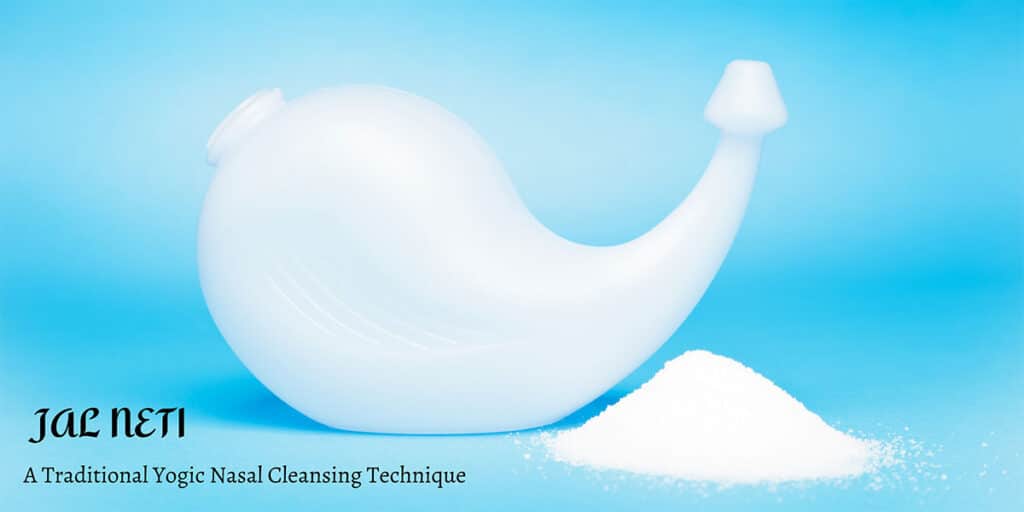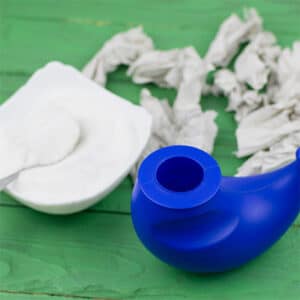Jala Neti for Beginners: Everything You Need to Know
by Hardik Mehta

Jala Neti for Beginners: Everything You Need to Know
Jala Neti, a simple yet powerful yogic practice, has been used for centuries to maintain respiratory health and promote overall well-being. In Sanskrit, “jala” means water, and “neti” refers to a cleansing practice. Originating from the ancient science of Hatha Yoga, Jala Neti is a nasal cleansing technique that involves flushing the nasal passages with a saline solution. It helps remove accumulated dirt, dust, allergens and mucus, thereby improving breathing, reducing sinus issues and preventing infections.
For beginners, learning and understanding Jala Neti can be a transformative experience. This blog will guide you through everything you need to know about Jala Neti, from its benefits and technique to precautions and tips for success.
Benefits of Jala Neti
- Clears Nasal Congestion and Sinuses
One of the most immediate and noticeable benefits of Jala Neti is the relief from nasal congestion caused by colds, allergies or sinusitis. By flushing out mucus, pollen, dust and other irritants, Jala Neti opens up the nasal passages, allowing for easier breathing. It also helps reduce sinus pressure, which can cause headaches or facial pain.
- Prevents Respiratory Infections
The saline solution used in Jala Neti creates an environment that is hostile to bacteria and viruses, helping to prevent infections. Regular practice of Jala Neti can lower the risk of respiratory infections like colds, flu and sinusitis by maintaining clean nasal passages.
- Reduces Allergies
People suffering from allergies, particularly to dust, pollen or pet dander, can benefit from Jala Neti. The practice helps to clear out allergens trapped in the nasal passages, reducing allergic reactions such as sneezing, itching and watery eyes.
- Enhances Breathing
For yogis, breath control or Pranayama is an essential part of practice. Jala Neti enhances the ability to breathe freely and deeply, improving lung capacity. This can be particularly beneficial for people practicing yoga, meditation, or even athletes looking to improve their respiratory performance.
- Improves Focus and Mental Clarity
By clearing out the nasal passages and improving the flow of prana, Jala Neti helps sharpen mental clarity and concentration. Many practitioners report feeling more focused and alert after performing Jala Neti. The practice is also said to activate the Ajna Chakra, which is associated with intuition and mental clarity.
- Relieves Stress and Anxiety
Breathing difficulties can exacerbate feelings of stress and anxiety. By allowing for smooth and unimpeded breathing, Jala Neti helps promote relaxation and reduces stress. Improved breathing also enhances the body’s oxygenation process, which plays a role in calming the mind.
- Supports Eye and Ear Health
Interestingly, Jala Neti is said to benefit not just the nasal passages but also the health of the eyes and ears. It can help reduce eye strain, particularly for people who spend long hours in front of screens. In terms of ear health, the practice can assist in draining excess fluid from the Eustachian tubes, helping to prevent ear infections and maintain balance in the ear canals.
How to Perform Jala Neti: A Step-by-Step Guide
Now that you understand the benefits of Jala Neti, let’s dive into how you can practice it. While it may seem daunting at first, the process is simple and straightforward once you get the hang of it.
What You’ll Need

- A Neti pot (a small pot with a spout designed for nasal irrigation)
- Lukewarm, distilled, or previously boiled water
- Non-iodized salt (preferably Himalayan salt or sea salt)
- The ratio is usually half a teaspoon of salt per 500ml of water. The solution should be similar to the body’s natural salinity level (0.9% saline), making it gentle on the nasal membranes.
Step-by-Step Instructions:
- Position Yourself: Stand over a sink and tilt your head to one side. Keep your mouth open so you can breathe through it during the process.
- Insert the Neti Pot Spout: Place the spout of the Neti pot into the upper nostril, creating a gentle seal.
- Pour the Water: Tilt the pot so the water flows into your upper nostril and out through the lower nostril. The water should flow smoothly without force. Continue breathing through your mouth.
- Switch Sides: Once the water has drained from one nostril, switch sides. Tilt your head in the opposite direction and repeat the process, pouring water into the other nostril.
- Clear the Nasal Passages: After completing the irrigation on both sides, gently blow out any remaining water from your nose. Avoid forceful blowing, as it may push water into your ears.
- Dry the Nose: Stand up straight and lean forward slightly while gently exhaling through your nose to ensure all water is cleared from the nasal passages.
Precautions and Tips for Beginners
While Jala Neti is generally safe, there are a few precautions beginners should take to ensure a comfortable and effective experience:
- Use Distilled or Sterile Water: Always use distilled, sterile, or previously boiled water for the saline solution to prevent the introduction of harmful microorganisms into the nasal passages. Tap water, particularly in some regions, can contain bacteria or parasites that are harmful if introduced into the nasal cavities.
- Maintain Proper Hygiene: Ensure that your Neti pot is clean and sanitized before each use. After using it, wash the pot thoroughly and allow it to dry.
- Avoid Overuse: While Jala Neti can be performed daily, excessive use may irritate the nasal passages or cause dryness. It’s important to find a balance and listen to your body.
- Be Cautious During Illness: If you have a severe infection, nasal injury, or are recovering from surgery, it’s advisable to consult a healthcare professional before practicing Jala Neti. Additionally, those with chronic nosebleeds should exercise caution and seek advice from a medical professional.
- Be Gentle: Don’t force the water to flow faster than it should. Let gravity do the work, and pour the water slowly to avoid discomfort or irritation.
- Practice at the Right Time: The best time to practice Jala Neti is in the morning, before breakfast, or before your yoga or meditation practice. It can also be done in the evening, but avoid practicing it right before bed as your nasal passages need time to dry completely.
- Dry Your Nose Properly: Ensuring that your nasal passages are fully dry is crucial to avoid water retention in the sinuses. After completing the process, gently blow your nose and tilt your head forward to allow any remaining water to drain.
Jala Neti is a time-honoured practice that offers numerous health benefits, especially for the respiratory system. From clearing nasal congestion to enhancing mental clarity, this simple yet powerful technique has the potential to improve physical health, mental well-being, and spiritual awareness. Whether you are a seasoned yogi or someone looking for a natural way to maintain nasal hygiene, Jala Neti can be a valuable addition to your daily routine. With proper technique, mindfulness, and respect for the practice, Jala Neti can become a transformative tool for holistic health.
Sayujya Yoga is one of Mumbai’s premier yoga institutes, renowned for its holistic approach. We offer both 200 Hours Teacher Training Courses and short courses, blending deep-rooted philosophies with contemporary practices to provide a comprehensive and transformative experience for all practitioners.
About the Author

Hardik Mehta
Hardik is an E-RYT 500 & YACEP (Yoga Alliance Continuing Education Provider), Yoga Alliance, USA. He has been practicing yoga for the last 9 years. Prior to finding his true calling in Yoga, he was working with various corporates for 12 years in the Retail and eCommerce sector.
